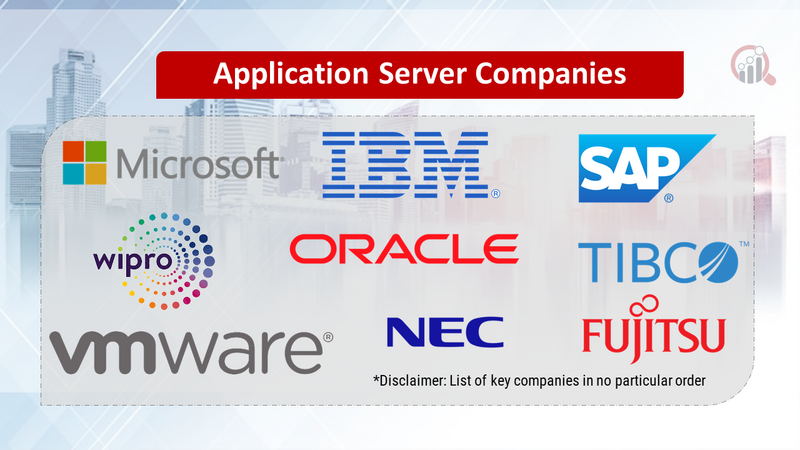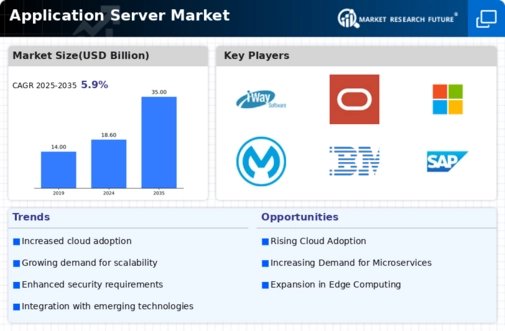Top Industry Leaders in the Application Server Market
 Navigating the Application Server Labyrinth: A Look at the Competitive Landscape
Navigating the Application Server Labyrinth: A Look at the Competitive Landscape
The application server market is a bustling hub, facilitating the development and deployment of web applications that power our digital world. From e-commerce platforms and social media giants to corporate intranets and critical software systems, application servers serve as the invisible backbone, orchestrating the interaction between user interfaces and databases. This dynamic landscape is home to a diverse range of players, each vying for market share with distinct strategies and offerings.
Key Players:
- Microsoft Corporation (US)
- IBM Corporation (US)
- Oracle Corporation (US)
- TIBCO Software Inc. (US)
- The Apache Software Foundation (US)
- Fujitsu Group (Japan)
- VMware Inc. (US)
- NEC Corporation (Japan)
- SAP SE (Germany)
- Wipro (India)
- Adobe Systems Inc. (US)
- iWay Software (US)
- Pega Systems (US) CA Technologies (US)
- Nastel Technologies (US)
Strategies for Market Share:
-
Cloud Focus: With the cloud migration wave in full swing, players are prioritizing robust cloud-based offerings. AWS's continuous expansion of features and Azure's focus on hybrid cloud deployments exemplify this strategy. -
Microservices and Containerization: Adapting to the trend of microservices and containerized applications is crucial. Red Hat's OpenShift platform and Google Cloud Platform's Kubernetes Engine cater to this growing segment. -
Security and Compliance: Stringent data security and compliance requirements are paramount. Oracle's focus on enterprise security features and IBM's compliance certifications for regulated industries attract specific customer segments. -
Ease of Use and Developer Experience: Intuitive interfaces, automation tools, and developer-friendly documentation are key for user adoption. Spring Boot's focus on rapid development and Tomcat's simple configuration attract developers.
Factors for Market Share Analysis:
-
Revenue and Market Share: These primary metrics offer insights into a player's financial strength and dominance within the market. However, they don't always reflect innovation or agility. -
Technology and Features: The type of underlying architecture, supported programming languages, and available features like server clustering and load balancing significantly impact a player's competitive edge. AWS's extensive serverless capabilities and F5's advanced traffic management tools illustrate this factor. -
Target Market and Customer Base: The types of customers a provider serves (enterprises, SMBs, developers) and the industries they cater to (finance, healthcare, e-commerce) offer insights into their market focus and potential growth areas. NGINX's dominance in content delivery networks and Red Hat's strength in cloud-native deployments exemplify this factor. -
Community and Ecosystem: A strong developer community and ecosystem of integrations with other technology solutions contribute to long-term success. Open-source players like Tomcat and Spring Boot benefit from vibrant developer communities, while traditional vendors like Oracle and IBM offer extensive partnerships with technology providers.
New and Emerging Companies:
- Jelastic: Offers a container-based application server platform for cloud and on-premises deployments, focusing on scalability and portability.
- Aquantia: Specializes in high-performance web server software for real-time applications and data streaming, catering to latency-sensitive workloads.
- Keywhiz: Provides secure secrets management for applications, integrating with popular application servers to address growing security concerns.
Current Investment Trends:
-
Hybrid and Multi-Cloud Deployments: Businesses are increasingly opting for hybrid deployments, combining on-premises application servers with cloud-based solutions. Providers are investing in platforms that facilitate seamless integration and management across diverse environments. -
Artificial Intelligence (AI) and Machine Learning (ML) Integration: Application servers are being integrated with AI and ML tools for automated application management, performance optimization, and security threat detection. Providers like Jelastic and F5 are exploring this area. -
Edge Computing: Bringing application servers closer to the data source is crucial for latency-critical applications like IoT and autonomous vehicles. Providers are exploring edge computing solutions to address this emerging need.
Latest Company Updates:
-
Red Hat unveils OpenShift 5: Red Hat recently launched OpenShift 5, its next-generation container platform offering enhanced developer experience and security features. -
Microsoft Azure Spring Cloud expands globally: Microsoft has expanded its Azure Spring Cloud offering to more regions, catering to the growing demand for cloud-based application server solutions. -
Tomcat 10.1.0 released: The Apache Software Foundation released Tomcat 10.1.0, featuring improved performance, stability, and security updates.










